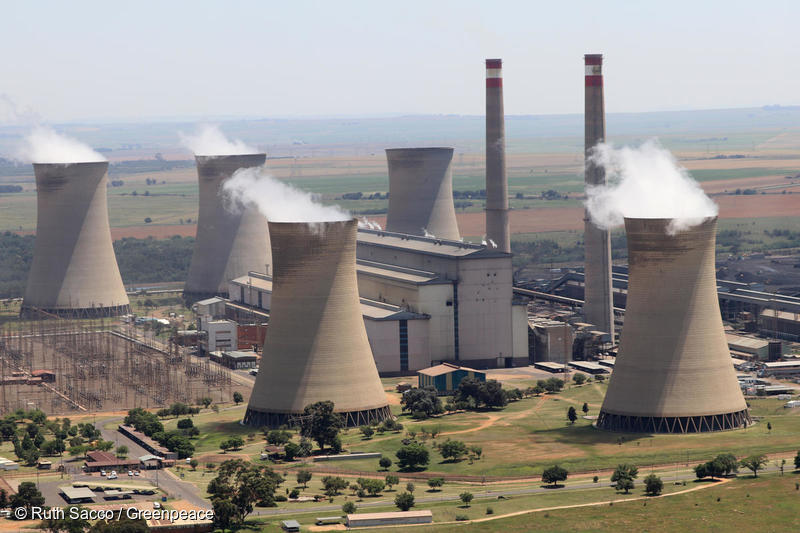The Toxic Air We Breathe: Greenpeace Maps Africa’s Air Pollution Hotspots – Greenpeace Africa
The Toxic Air We Breathe: Greenpeace Maps Africa's Air Pollution Hotspots greenpeace.org


Major Air Polluters in Africa Unmasked
Johannesburg, 28 March 2024

Egypt, Nigeria, and South Africa have emerged as Africa’s most polluted countries in terms of air pollution disease burden, with profound health consequences for Africa’s people and exacerbated impacts on climate change, a report prepared by Greenpeace Africa and Greenpeace MENA can now reveal.
The report titled “Major Air Polluters in Africa Unmasked” investigates the biggest human sources of air pollution across Africa, focusing on major industrial and economic sectors, including the fossil fuel industry. Every year in Africa, as many as 1.1 million premature deaths have been linked to air pollution.
Key Findings
- Exposure to air pollution is the second leading risk factor for death in Africa (HEI 2022), and achieving World Health Organization guidelines could result in significant gains in life expectancy.
- Pollutant emissions lead to a considerable number of premature deaths in Africa. Egypt, Nigeria, and South Africa consistently exhibit large disease burdens, with the highest mortality linked to fossil fuel air pollution in these nations.
- Six of the world’s ten largest NO2 emission hotspots identified were found in Africa, all in South Africa.
- Of the ten largest SO2 point sources identified in Africa, nine are thermal power stations, and one is linked to a smelter complex in Mali. Four of the power plants are located in South Africa owned by ESKOM, two in Morocco and Egypt, and one in Zimbabwe.
- Health impact studies suggest that life expectancy could be improved by up to 3 years in some African nations if air quality met WHO guidelines.
The report found that Africa is home to some of the worst nitrogen dioxide and sulphur dioxide hotspots in the world, all of which are primarily linked to thermal power plants. The report also found that Eskom, a public utility company that has the government of South Africa as its sole shareholder, operates many of the most polluting plants in South Africa.
According to the World Health Organisation, exposure to air pollution, including nitrogen dioxide and sulfur dioxide, can cause both short- and long-term health problems. These include heart and lung diseases, pregnancy problems, kidney issues and cancer.
The report presents recommendations to address the critical issue of air pollution in Africa, emphasising the need for investment in clean technologies, especially in the energy sector. International institutions share a significant responsibility in sustainably developing the African continent.
Many of the causes of air pollution, such as the combustion of oil, coal, and gas, are also sources of greenhouse gas emissions. Policies aimed at reducing air pollution, therefore, offer a win-win strategy for both climate and health.
“We urgently call upon North African governments to adopt the report’s recommendations particularly the installation of air quality monitors and ensuring access to real-time data. This proactive approach empowers affected communities to address their governments for action, to take charge of their well-being, make informed decisions, and collectively work towards cleaner and healthier environments” stresses Sarra Ben Abdallah, Greenpeace MENA Campaigner.
“For too long, the people of Mpumalanga have borne the burden of South Africa’s coal dependency, not just in the air we breathe but in the opportunities we’re denied. The pollution from coal plants like those operated by Sasol in our region has not only tarnished our health, leading to failed health assessments and chronic diseases, but it has also clouded our future, leaving us jobless as companies opt to hire from outside, citing our ‘unfitness’ for work. This report by Greenpeace sheds light on our struggle, linking every breath of polluted air to the systemic injustice that fuels unemployment and health disparities in Secunda,” said Fana Sibanyoni, an activist from the Mpumalanga region.
ENDS
Notes:
- The report emphasises the sparse monitoring of air quality in Africa, revealing that the WHO’s 2023 Ambient Air Quality Database includes data from just 14 countries within continental Africa. IQAir’s World Air Quality report for 2022 which draws data from an even wider range of sources found that monitoring data is available in just 19 of Africa’s 54 countries. Similarly, only 19 African countries have legislation incorporating ambient air quality standards, according to the First Global Assessment of Air Pollution Legislation by the United Nations Environmental Programme.
Contacts:
- Greenpeace Africa: Ferdinand Omondi, Communication and Story Manager. +254 722 505 233, [email protected]; Press Desk Africa @greenpeacepress
SDGs, Targets, and Indicators
1. Which SDGs are addressed or connected to the issues highlighted in the article?
- SDG 3: Good Health and Well-being
- SDG 7: Affordable and Clean Energy
- SDG 11: Sustainable Cities and Communities
- SDG 13: Climate Action
- SDG 15: Life on Land
2. What specific targets under those SDGs can be identified based on the article’s content?
- SDG 3.9: By 2030, substantially reduce the number of deaths and illnesses from hazardous chemicals and air, water, and soil pollution and contamination.
- SDG 7.1: By 2030, ensure universal access to affordable, reliable, and modern energy services.
- SDG 11.6: By 2030, reduce the adverse per capita environmental impact of cities, including by paying special attention to air quality and municipal and other waste management.
- SDG 13.1: Strengthen resilience and adaptive capacity to climate-related hazards and natural disasters in all countries.
- SDG 15.1: By 2020, ensure the conservation, restoration, and sustainable use of terrestrial and inland freshwater ecosystems and their services, in particular forests, wetlands, mountains, and drylands, in line with obligations under international agreements.
3. Are there any indicators mentioned or implied in the article that can be used to measure progress towards the identified targets?
- Air pollution-related premature deaths in Africa
- Number and location of major air pollutant emitters
- Number and location of nitrogen dioxide and sulphur dioxide hotspots
- Number and location of thermal power plants emitting pollutants
- Life expectancy improvement in African nations if air quality meets WHO guidelines
Table: SDGs, Targets, and Indicators
| SDGs | Targets | Indicators |
|---|---|---|
| SDG 3: Good Health and Well-being | 3.9: By 2030, substantially reduce the number of deaths and illnesses from hazardous chemicals and air, water, and soil pollution and contamination. | – Air pollution-related premature deaths in Africa |
| SDG 7: Affordable and Clean Energy | 7.1: By 2030, ensure universal access to affordable, reliable, and modern energy services. | – Number and location of major air pollutant emitters – Number and location of thermal power plants emitting pollutants |
| SDG 11: Sustainable Cities and Communities | 11.6: By 2030, reduce the adverse per capita environmental impact of cities, including by paying special attention to air quality and municipal and other waste management. | – Number and location of nitrogen dioxide and sulphur dioxide hotspots |
| SDG 13: Climate Action | 13.1: Strengthen resilience and adaptive capacity to climate-related hazards and natural disasters in all countries. | – Number and location of major air pollutant emitters |
| SDG 15: Life on Land | 15.1: By 2020, ensure the conservation, restoration, and sustainable use of terrestrial and inland freshwater ecosystems and their services, in particular forests, wetlands, mountains, and drylands, in line with obligations under international agreements. | – Number and location of major air pollutant emitters |
Behold! This splendid article springs forth from the wellspring of knowledge, shaped by a wondrous proprietary AI technology that delved into a vast ocean of data, illuminating the path towards the Sustainable Development Goals. Remember that all rights are reserved by SDG Investors LLC, empowering us to champion progress together.
Source: greenpeace.org

Join us, as fellow seekers of change, on a transformative journey at https://sdgtalks.ai/welcome, where you can become a member and actively contribute to shaping a brighter future.







